The Conservation Classroom
Explore our free curriculum-linked teaching resources that will support children to develop an appreciation for the natural world around us, highlight threats to our oceans and encourage them take action in their local communities. Select the relevant age of your students via these quick links or scroll the page for ideas and inspiration.
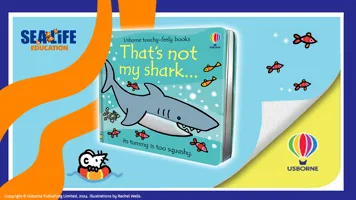
SEA LIFE Play Cards
Make a splash and spark curiosity about sharks and sea creatures with these under the sea sensory activities and craft ideas for at home with the family or adaptable for any Early Years setting.
Inspired by That's not my shark... an Usborne touchy-feely book, these free play cards have built in EYFS curriculum and early learning goals. If you are up for getting a little messy with your little learners, they are packed full of activities that will not only develop early literacy, communication and fine and gross motor skills but also problem-solving and imagination, all while helping children explore the world around them – and having lots of fun along the way!
When it comes to onsite immersive learning we have also created a bespoke EYFS School Trip Teacher Guide for educators.

Play Card 1: Under the Sea Reading Den
Get the crafts out to create an under the sea imaginative play and storytelling den using material, lights, and homemade decorations.
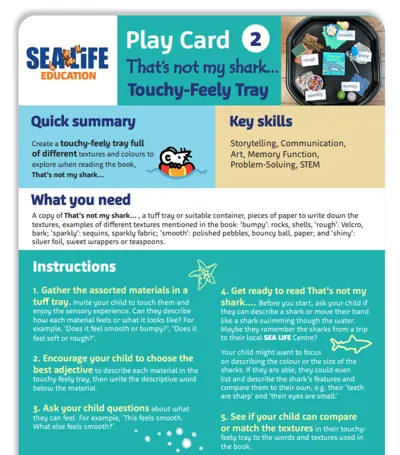
Play Card 2: That's not my shark... Touchy-Feely Tray
Create a tuff tray or baby sensory box full of different textures and colours to accompany a read aloud session of the book, That’s not my shark.
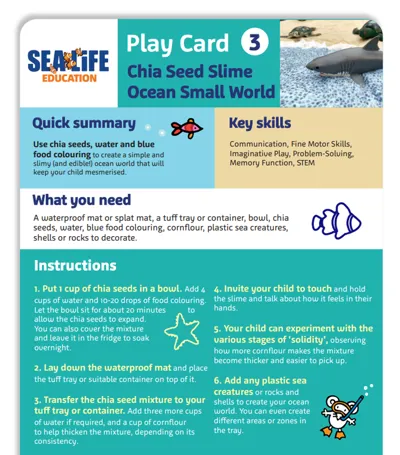
Play Card 3: Chia Seed Slime Ocean Small World
There is always one.. the messy play idea! Use chia seeds to create a simple and slimy ocean world that will keep children mesmerised
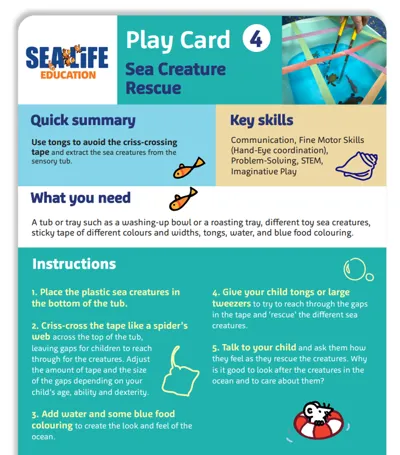
Play Card 4: Sea Creature Rescue
A fun group activity, use tongs to avoid the criss-crossing tape and rescue the sea creatures from the sensory bin
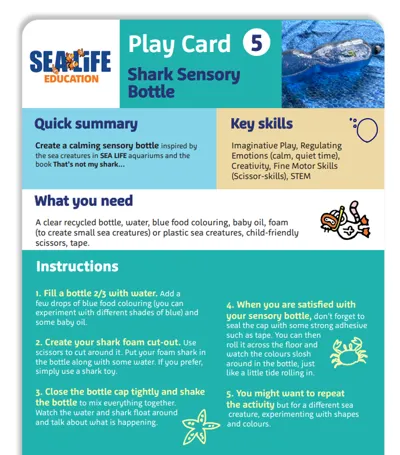
Play Card 5: Shark Sensory Bottle
Create a sense of calm with a sensory bottle inspired by all the creatures you can find in the sea
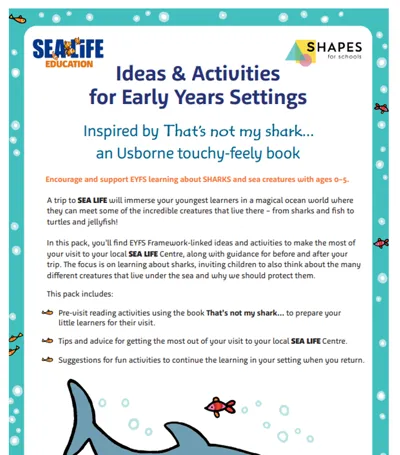
Take learning beyond the classroom - EYFS School Trip Teacher Guide
Discover our pre-visit reading activities using the book That’s not my shark..., tips and advice for getting the most out of your visit plus ideas for continued learning post visit.
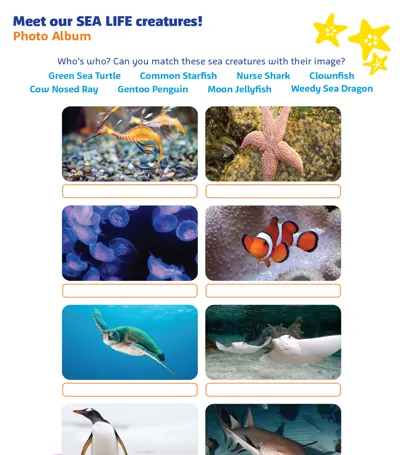
Meet our SEA LIFE creatures!
Can you match the ‘creature features’ to the correct creature from the SEA LIFE Creatures Photo Album? [Animals and living creatures (Science)]
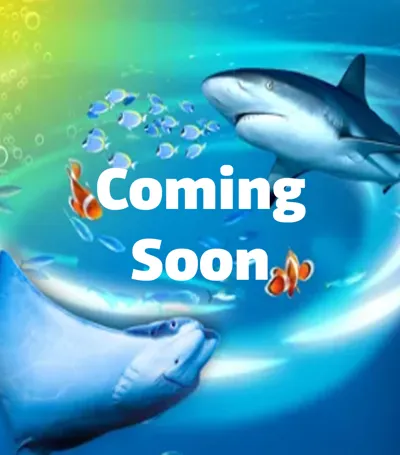
What Will I Find in the Ocean?
Learn to identify animals that live in the ocean and begin to recognise that not all sea animals are fish. [Animals and Living Creatures (Science)]

Describing sea creatures
Using the Word Mat, can you take turns to describe any sea creatures you know about? [Writing opportunities (English / Literacy)]

Which Ocean Do I Live In?
Explore the world’s oceans and learn that different sea animals live in different environments. [Habitats and Environments (Science, Geography)]

What Belongs in the Ocean?
Understand that some objects (especially rubbish) do not belong in the ocean and that humans can help protect habitats. [Protection and Conservation (PSHE, Citizenship, Science)]
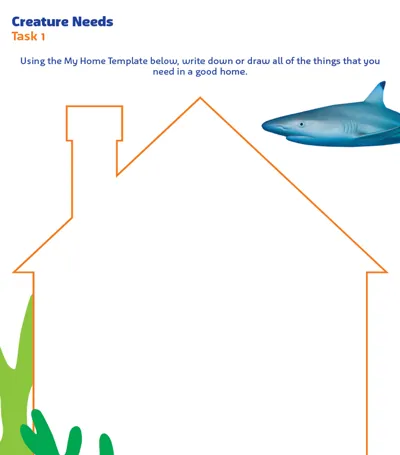
Creature needs
Write down or draw all of the things that you need in a good home. How does this compare to creature needs? [Habitats and environments (Science and Geography)]

Save Our Seas: The Rangers Challenge
Become the ultimate ocean conservation champion with a trip to your local SEA LIFE and this free challenge pack.
Key Learning Outcomes (Age 5-11)
- Consider the different sea creatures they’ll encounter and their habitats.
- Appreciate how sea creatures are being negatively impacted by human behaviour.
- Learn what can be done to help protect the sea creatures and their habitats
Explore the activity pack (Age 5-11)

Meet our SEA LIFE creatures!
Can you match the ‘creature features’ to the correct creature from the SEA LIFE Creatures Photo Album? [Animals and living creatures (Science)]

Are All Sea Creatures Fish?
Classify sea animals into scientific groups and explain why not all sea creatures are fish. [Animals and Living Creatures (Science)]
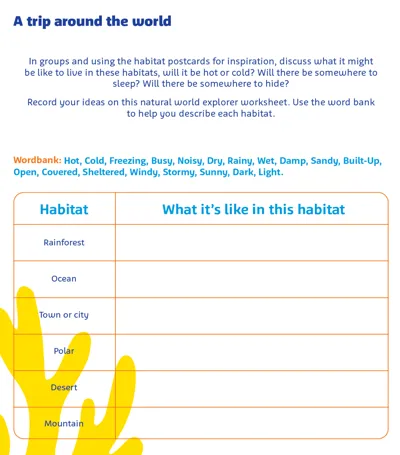
A trip around the world
In groups and using the habitat postcards for inspiration, discuss what it might be like to live in different habitats. [Habitats and environments (Science and Geography)]

Coral Reef or Open Ocean?
Compare two marine habitats and explain how animals are adapted to live there. [Habitats and Environments (Science, Geography)]
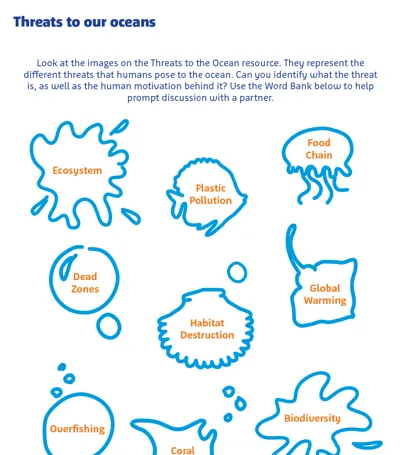
Identifying threats to our oceans
Can you identify what the threat is, as well as the human motivation behind it? Use the Word Bank to help prompt discussion with a partner. [Protection and conservation (PSHE / Citizenship)]
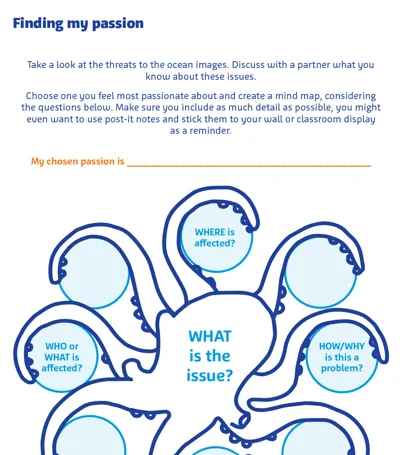
Finding my Ocean passion
Create a mind map about a threat to the Ocean you feel passionate about. [Protection and conservation (PSHE / Citizenship)]
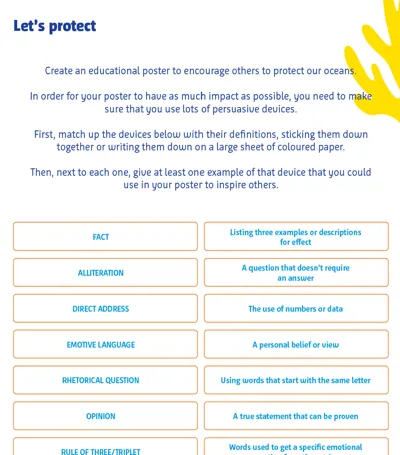
Let's protect
Create an educational poster to encourage others to protect our oceans. [Protection and conservation (PSHE / Citizenship)]
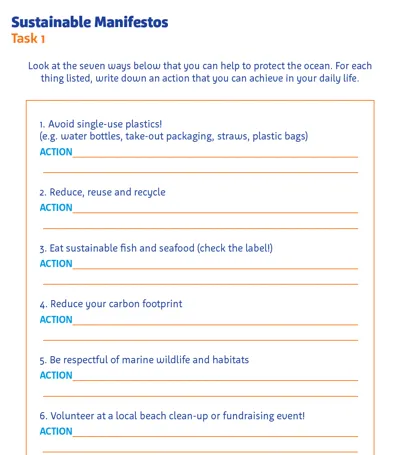
Sustainable Manifestos
Look at the seven ways that you can help to protect the ocean. For each thing listed, write down an action that you can achieve in your daily life. [Protection and conservation (PSHE / Citizenship)]

Diary of a Deep Sea Explorer
Produce a diary entry using first person, descriptive language and sensory detail to bring an underwater setting to life [Writing Opportunities (English)]

Join the Mission...
By understanding how everything is connected in the ocean and how we interact with it as humans, children will learn to care and protect the ocean because they will want it to be a better place – not just for the creatures that live there, but for themselves too.
Turn your classroom in conservation HQ with this free mission pack. Choose from a selection of conservation challenge cards focusing on oceans and waterways and how they are under threat, all leading to the creation of a piece of work or community campaign that showcases your class or whole-school journey to becoming #SEALIFEFriends.
Dive in and discover more (Age 7-11)

Save Our Seas: The Rangers Challenge
Become the ultimate ocean conservation champion with a trip to your local SEA LIFE and this free challenge pack.
Key Learning Outcomes (Age 5-11)
- Consider the different sea creatures they’ll encounter and their habitats.
- Appreciate how sea creatures are being negatively impacted by human behaviour.
- Learn what can be done to help protect the sea creatures and their habitats
Explore the activity pack (Age 5-11)
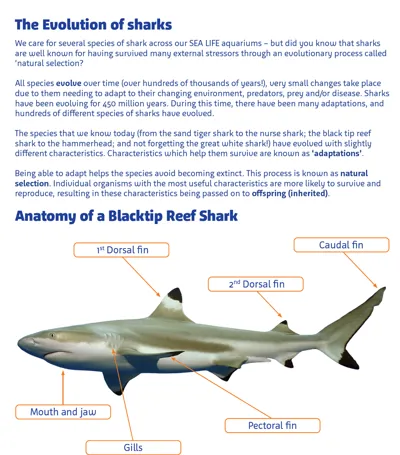
The Evolution of Sharks – Natural selection (KS3 / S1-3)
Considering a case study of sharks, identify why specific adaptations are effective characteristics that have been inherited by offspring, through the process of natural selection. Why do these adaptations make sharks great survivors and predators, over hundreds of thousands of years? [Animals and living creatures (Science)]

Critical conservation (KS3 / S1-3)
By extracting information from the case study, rank in order which issues you believe (decision making based on information presented) to be the biggest conservation issues to sea creatures. Present key information about the ways that this impact could be changed, drawing on the case study of the work of SEA LIFE centres. [Protection and conservation (PSHE / Citizenship) | Writing opportunities (English / Literacy)]
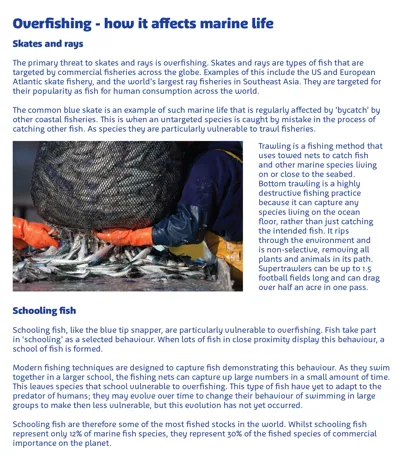
Animals in danger – over fishing (KS3 / S1-3)
You have been asked by SEA LIFE to create engaging sentences / small paragraphs for a display board by one of the fish tanks on the dangers of over fishing on various species of fish. Use the imagery and the article information to extract your key ideas, and present your information in a way that informs and engages visitors to the centres. [Habitats and environments (Science and Geography) | Protection and conservation (PSHE / Citizenship) | Writing opportunities (English / Literacy)]
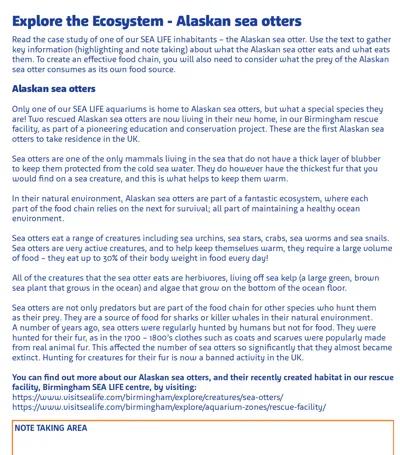
Explore the ecosystem! (KS3 / S1-3)
Using the template, create a food chain / food web based on the case study. Identify interdependence / reliance of creature /organisms on each other in the given ocean environment. [Animals and living creatures (Science)]
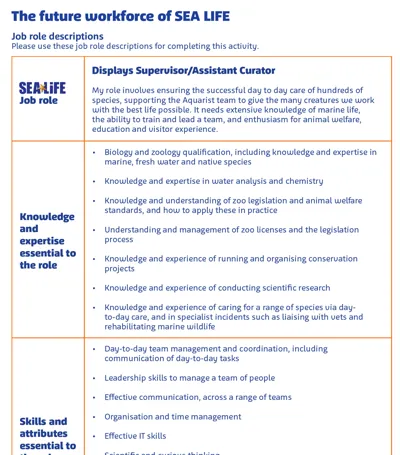
The future workforce of SEA LIFE… (KS3 / S1-3)
From reading the job descriptions identify: 3 areas of specialist knowledge that the member of staff uses in their role, and why this knowledge is vital in their role. 3 skills/attributes that a member of SEA LIFE staff uses regularly within their role, and why these are important.
Discover your local SEA LIFE
Latest news and teaching inspiration

Ocean Conservation: Why Little Splashers Make Big Waves
Active citizenship might sound like something only MPs do, but for kids, it’s all about turning empathy into action. That’s where SEA LIFE’s Friends of the Sea initiative comes in. Think of it as a superhero training camp, minus the capes (although, who am I to stop you?)

Dive into Learning: How Aquarium Trips Inspire Knowledge, Empathy, and Love for the Ocean
Planning a geography or science school trip can be a lot of work, but watching a child’s eyes light up when they enter an aquarium is a joy to behold. It’s a journey into the ocean’s mysteries, a chance to inspire empathy, and an opportunity to show students how interconnected our world truly is.

How a School Aquarium Trip Can Help Students Feel Calm
It’s no secret that the wellbeing of our children has taken a hit in recent years. From pandemic disruptions to the ever insisting presence of social media, young people face a barrage of pressures previous generations could never have imagined. However, what if there was a way to make learning about wellbeing fun, engaging, and memorable? Enter the humble aquarium trip!

Creative, captivating and colourful: Ocean-inspired learning for KS1&2
The world’s oceans are full of hidden depths when it comes to cross-curricular learning for KS1&2 teachers. Here are five ideas for ocean-themed projects – and how to integrate them into the classroom.